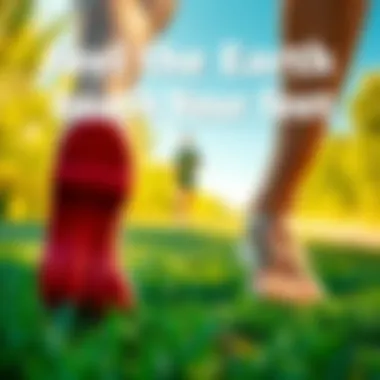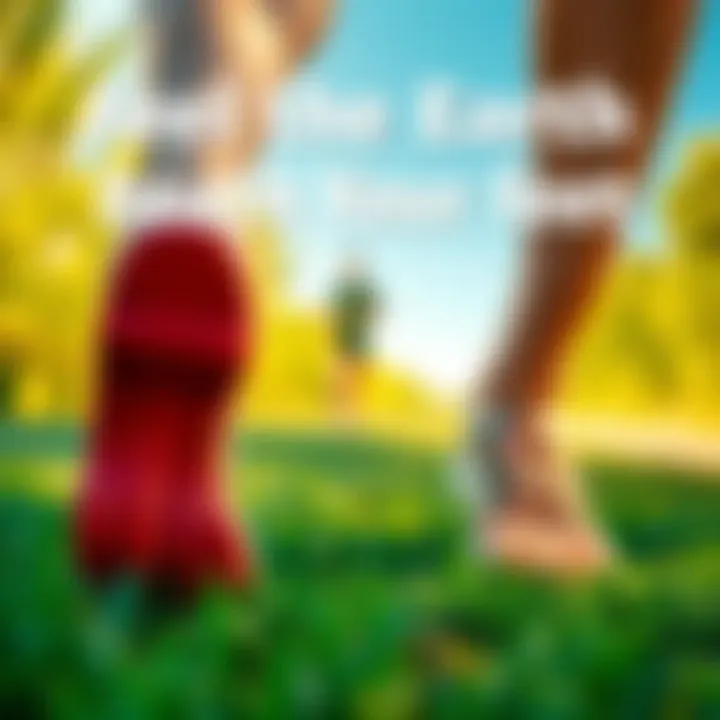Insights into Barefoot Running: Literature and Practice


Intro
The practice of running without the comfort and protection of shoes has been gaining traction among fitness enthusiasts and casual joggers alike. With a surge in interest comes a treasure trove of literature that provides insights into the intricacies of barefoot running. What might seem at first glance as a whimsical endeavor has its roots in serious research, backed by notable authors and researchers who illuminated the physical, mental, and environmental aspects of this running style. As we explore the contemporary narrative around barefoot running, we aim to synthesize what's been gleaned from key texts and research papers, offering both seasoned runners and novices a comprehensive look into this exhilarating movement.
Understanding the benefits and challenges identified in literature can empower individuals to make informed decisions about embarking on their barefoot running journey. The following sections will break down these insights, delving into various themes and practical recommendations that together weave a rich tapestry of knowledge surrounding this subject.
Categories of Relevant Literature
Self-Help and Personal Development
Books in this category are essential for anyone looking to transition into barefoot running. They often address the psychological barriers one might face, such as fear of injuries or the challenge of adapting to a new running style. Some renowned works highlight practical tips to reshape one’s mindset, fostering resilience and encouraging a holistic view of fitness. For instance, Born to Run by Christopher McDougall not only shares personal stories but also encourages readers to embrace discomfort and redefine their limits, making it a powerful ally for those venturing into barefoot running.
Fiction with Transformative Themes
Interestingly, certain fictional works touch upon journeys of self-discovery that parallel the experience of barefoot running. This literature can motivate individuals to overcome internal and external struggles. Such narratives provoke thoughts on freedom, community, and the shared human experience in ways that can be surprisingly helpful when approaching a new physical venture.
Book Summaries and Insights
Key Takeaways from Popular Titles
- Born to Run: Explores the connection between humans and the natural ability to run long distances barefoot. Highlights the role of biomechanics and the importance of natural running forms.
- The Barefoot Book: A practical guide that discusses the physical benefits of running without shoes and provides reader-friendly tips on how to transition safely.
- Run Wild: A collection of essays that bolster the idea of reclaiming running from urban environments and shoes.
How to Apply Insights in Daily Life
To weave these insights into your daily routine, consider the following:
- Start gradually: Transition from cushioned running shoes to barefoot running over weeks to minimize injury risks.
- Practice mindfulness: While running, focus on the sensations of your feet hitting the ground, allowing for a deeper connection to your environment.
- Engage with community: Join local workshops or online forums that focus on barefoot running, enriching your understanding through shared experiences.
Intro to Barefoot Running Literature
The exploration of barefoot running is not just a fad; it holds significant weight in both the athletic and health communities. This section looks at how literature has shaped the conversation around this increasingly popular practice. Books and articles delve into the benefits and intricacies of running without shoes, going beyond mere personal testimonies to present compelling arguments backed by research. Understanding the depth of this topic is crucial for enthusiasts and newcomers alike, as it provides insight into safe practices, cultural significance, and the physiological benefits of running barefoot.
Historical Context
The historical context of barefoot running is rich and varied, tracing back through cultures that revered this natural form of moving. For instance, indigenous tribes from various regions, including the Tarahumara of Mexico, have long embraced barefoot running as an integral part of their lifestyle, relying on the natural terrain for both sport and survival. The rise of modern running shoes in the late 20th century shifted this perspective, often leading to skepticism around the effectiveness of running sans shoes. Authors in the field, like Christopher McDougall in "Born to Run," explore these historical narratives, advocating for a return to the roots of running as a way to enhance performance and well-being. In essence, digging into the past offers not only clarity about why barefoot running is gaining traction again but also aligns it with broader discussions about natural movement and athletic performance.
Cultural Perspectives on Running
Cultural perspectives on running reveal fascinating insights into how societies perceive and adapt the practice of running barefoot. In many cultures, running is more than just an activity; it is an expression of identity, connection to the land, and tradition. For instance, within certain African and South American communities, running is a rite of passage, celebrated for its connection to ancestral practices. Conversely, in some Western cultures, barefoot running challenges deeply ingrained beliefs around safety, health, and athleticism associated with modern footwear. This conflict reveals how literature can serve as a bridge, shedding light on different practices and beliefs while encouraging a broader understanding of what running means across the globe.
As you absorb this foundational knowledge, you are better equipped to appreciate the multifaceted world of barefoot running. Whether through historical context or cultural narratives, literature serves as a lens through which we can understand our relationship with this age-old practice.
Key Texts in Barefoot Running
The topic of key texts in barefoot running holds significant weight in understanding the evolution of this increasingly popular practice. By engaging with the literature, readers can uncover the historical, cultural, and practical aspects of barefoot running that shape modern running culture. These texts not only offer insights into the physiological and psychological benefits but also reveal the controversies surrounding this style of running. Within this section, we will dive into the contributions of notable authors, as well as provide an overview of influential works that form the cornerstone of barefoot running literature.
Notable Authors and Their Contributions
Several authors have diligently explored barefoot running, bringing diverse perspectives and experiences to the table. One of the most prominent figures is Christopher McDougall, whose book, "Born to Run," ignited a wildfire of interest in the topic. McDougall narrates the story of the Tarahumara, a tribe in Mexico known for their incredible long-distance running abilities. His tales push readers to reconsider conventional running footwear and approach running from a natural perspective.
Another key contributor in this niche is Eric Orton, who assists runners in transitioning to barefoot techniques judiciously. His book, "The Cool Impossible," emphasizes the importance of form and technique, offering practical advice for those looking to step away from traditional shoe wear.
Beyond individual narratives, authors like Michael S. Sandler and Jessica Lee, in their work "Barefoot Running: How to Run Light and Free by Getting in Touch with the Earth," emphasize the need for connecting with natural terrain. Their focus on mindfulness speaks to those seeking a deeper connection with their environment through running. Each author brings their unique voice and expertise, making their contributions valuable to both novices and seasoned runners.


Overview of Influential Works
When delving into the key texts of barefoot running, certain works stand out not only for their popularity but also for their profound influence on budding runners and seasoned veterans alike.
- "Born to Run" by Christopher McDougall: This is, without a doubt, one of the seminal texts in barefoot literature. McDougall weaves an engaging narrative that blends anthropology, physiology, and the thrill of running, motivating many to ditch their shoes.
- "The Barefoot Revolution" by Michael Sandler: This book takes a practical approach, advocating for barefoot running through detailed exercises and training plans. Sandler’s work is often recommended for anyone wanting to make the shift gradually and safely.
- "Running with the Mind of Meditation" by Sakyong Mipham: While not solely focused on barefoot running, it elucidates the psychological aspects of running, threading together mindfulness and body awareness, which aligns beautifully with the barefoot philosophy.
- "The Cool Impossible" by Eric Orton: As mentioned earlier, Orton offers actionable strategies through personal anecdotes and expert insights, facilitating a transition to barefoot running.
These works contribute significantly to the evolving narrative around barefoot running. They equip readers with both the motivation and the knowledge to explore this running style and understand its implications on physical and mental well-being.
Through diving deep into these texts, one can grasp not only the benefits of barefoot running but also its challenges and nuances, enhancing one’s overall running experience.
Engagement with the literature allows runners, whether they are novices or seasoned athletes, to reflect on their habits and instills a deeper appreciation for how the past shapes the present.
Physiological Insights from Barefoot Running Books
Barefoot running, often seen as a departure from conventional running practices, has garnered growing interest in the sporting community. The physiological insights gleaned from various literature lay bare the underpinnings of this running style, offering a holistic view of its benefits and challenges. By dissecting aspects like biomechanics and muscle engagement, enthusiasts can understand the intricate dance of the body at play while traversing the world sans shoes.
Biomechanics of Running Styles
When it comes to barefoot running, understanding the biomechanics is crucial. Traditional running shoes often cushion the foot and alter the natural gait, but removing this support invites a fundamental shift in how the body moves. Literature on the subject frequently discusses how barefoot runners tend to adopt a forefoot or midfoot strike instead of the typical heel strike predominant among shod runners. This transition results in a more vertically aligned posture, reducing impact forces and potentially minimizing injuries associated with heel striking.
Key studies highlight that running without shoes can lead to more natural foot movements. The muscles, tendons, and ligaments work together in a coordinated manner, enhancing proprioception, the body’s ability to sense its position and movement. Educators and authors advocate that with increased engagement of the foot's muscles, there’s a better distribution of forces across the feet and legs. To sum it up, most literature underscores that a solid understanding of biomechanics can enable runners to make informed choices about their running style.
"Barefoot running teaches us to listen to our bodies, embracing a more authentic running experience."
Muscle Development and Injury Prevention
The connection between muscle development and injury prevention is a hot topic among proponents of barefoot running. Many advocates assert that running barefoot strengthens the intrinsic muscles of the foot, which play a pivotal role in stability and balance. Research indicates that as these muscles engage more, the risk of common injuries like plantar fasciitis and Achilles tendinopathy may decrease.
While barefoot running is not without its risks, particularly for those who jump into it without proper transition, the literature emphasizes a gradual approach. The focus is on fostering strength and flexibility in the feet and calves. Key points often mentioned include:
- Running on varied terrains enhances adaptive muscle responses.
- Gradual increases in mileage allow time for the body to adapt physically.
- Paying close attention to personal sensation and discomfort can guide training effectively.
As readers explore these insights, they are reminded that although barefoot running can offer substantial benefits, it requires a cultural and physiological shift. While the practice has its challenges, the rewards — both in terms of physical conditioning and fostering a deeper connection to the running experience — should encourage a thoughtful and considered approach to making this transition.
Psychological Aspects of Barefoot Running
Understanding the psychology behind barefoot running is crucial. This approach to running is not merely about physical fitness; it digs deep into the mental and emotional aspects of the practice. Running barefoot encourages a personal connection with nature, enhances awareness of one's body, and promotes mental clarity. These elements greatly contribute to creating a fulfilling running experience.
Mindfulness in Running
Running without shoes often leads to a deeper state of mindfulness. When barefoot, each step becomes a conscious choice; you feel the ground beneath your feet, and every surface presents a different challenge. This heightened awareness allows runners to engage with their surroundings fully, fostering a meditative state that can be quite liberating.
Research indicates that mindfulness during exercise can reduce stress, improve mood, and enhance overall satisfaction with one's running routine. The practice of paying close attention to each stride can result in not just physical benefits but a significant uplift in mental wellness.
Runners often report a feeling of freedom when they ditch the shoes. This sense of liberation plays a key role in mental well-being. They become more attuned to their bodies and the world around them, uncovering layers of sensory input that running in traditional footwear may have masked.
Motivation and Mental Resilience
Transitioning to barefoot running is as much a mental challenge as it is a physical one. Those who embark on this journey need drive and determination, often pushing through discomfort as they adapt to a new running style. In this process, runners can sharpen their mental resilience.
The benefits of cultivating a resilient mindset cannot be overstated. Barefoot runners often express that facing and overcoming the challenges associated with this transition—like soreness and adjustment periods—can lead to a more robust mental fortitude. This resilience extends beyond running, influencing various areas of life, from work to personal relationships.
Moreover, motivation plays a crucial role in this journey. Aligning with a community, whether offline or online, sharing experiences, or setting achievable goals can bolster one's commitment to transitioning. According to studies, this social aspect is vital in maintaining and enhancing motivation levels. These interactions create networks of support, encouraging runners to persist despite the inevitable challenges.
"Running barefoot facilitates not just physical training, but a form of mental conditioning that builds emotional strength and resilience."


Environmental Considerations in Barefoot Running
Barefoot running is not merely a personal choice regarding footwear; it emerges as a practice deeply interconnected with the environment. Understanding this connection expands our appreciation of the sport beyond simple performance metrics or injury prevention. Environmental considerations rooted in this practice highlight essential elements that benefit runners and the world they traverse.
Impact on Natural Terrain
One cannot discuss barefoot running without addressing its impact on natural terrains. Unlike traditional running shoes, which often isolate a runner's foot from direct contact with the ground, barefoot running promotes a more primal interaction with the earth. Feeling the varied textures of grass or dirt can significantly enhance sensory feedback, allowing runners to adjust their stride based on the terrain's surface. This relation fosters a deeper connection with nature, emphasizing awareness of one's environment. By running barefoot, enthusiasts might find themselves more cautious about uneven surfaces, thus reducing the likelihood of injuries caused by abrupt changes in terrain.
Furthermore, this practice has sparked conversations about trail conservation. Runners who bare their soles often advocate for minimal disruption in natural settings. Maintaining a light footprint, both physically and environmentally, is crucial. It encourages a respectful approach that prompts fewer invasive measures for trail development. As a result, local ecosystems experience less strain, preserving habitats and plant life crucial for biodiversity.
- Many barefoot runners report increased enjoyment in exploring trails that echo the ruggedness of nature.
- The conscientious decision to tread lightly encourages respect for the earth, promoting sustainability through direct engagement.
The essence of barefoot running fosters a naturalistic ethos, advocating for practices that emphasize harmony with nature rather than domination over it. This relationship becomes particularly relevant in areas where commercial development threatens natural landscapes, pushing runners to rise as advocates for conservation.
Sustainability and Minimalism
Sustainability and minimalism go hand-in-hand with barefoot running. The very act of choosing to run barefoot or in minimal footwear inherently leans toward a lifestyle that prioritizes sustainability. Traditional running shoes often come with a hefty environmental toll, from the materials used in production to the waste generated when they are discarded. By contrast, barefoot or minimalist running encourages mindful consumption.
Opting for fewer resources translates into less waste. Runners often discover that they can transition to durable, minimalist footwear constructed from recycled materials, promoting a cycle that values sustainability. But the call for minimum also transcends shoes; it encapsulates a broader lifestyle choice, *encouraging individuals to evaluate their consumption habits.
- Investing in quality gear made from eco-friendly materials instead of frequently purchasing fast-fashion athletic wear.
- Embracing a mindset that celebrates simplicity can lead to profound shifts not only in running but in everyday life decisions.
Ultimately, the bare approach to running extends beyond personal health benefits or performance improvements; it's a conscious call for a more sustainable future. This is a powerful reminder that our choices ripple through the environment. As we engage with the earth while running, we must consider how our actions impact the wider world.
"The most important things in life aren't things. " This quote reflects the minimalist philosophy that resonates well within the barefoot running community.
Practical Advice for Aspiring Barefoot Runners
When venturing into the realm of barefoot running, it’s vital for newcomers to equip themselves with suitable knowledge and tips. This section serves as a guide, offering practical advice designed to ease the transition as well as enhance the overall experience of running without shoes. The significance of this topic lies not just in safeguarding one’s physical well-being, but also in optimizing the benefits derived from this unique running style. Understanding the right steps to take before hitting the ground barefoot can make a world of difference.
Getting Started: Transitioning to Barefoot Running
Transitioning to barefoot running requires patience and foresight. It’s not simply a matter of slipping off your shoes and hitting the pavement. Many enthusiasts suggest starting gradually to allow the body to adapt to the new demands being placed upon it. Here are several critical steps:
- Start Slow: Begin by walking barefoot on grass or soft terrain to get used to the feeling. This can help strengthen the muscles in your feet.
- Short Distances: When you feel comfortable walking, try running short distances. Limit your runs to just a few minutes at first. This gives your body time to acclimatize.
- Incremental Increases: Increase your barefoot running distance by about 10% each week. This conservative approach helps to avert injuries.
- Listen to Your Body: Pay attention to how your feet and legs respond. Discomfort is normal, but pain is a sign that you need to dial it back a notch.
Choosing the Right Environment
Selecting the proper environment for barefoot running is crucial. Not all surfaces are created equal when it comes to running without shoes. Here are some considerations for finding the ideal setting:
- Soft Surfaces: Look for grass, dirt trails, or sand—these surfaces provide a softer landing than concrete, reducing impact stress.
- Clean Paths: Ensure the area is free of debris, glass, and sharp objects to minimize injury risk.
- Controlled Conditions: Start in familiar environments where you can control the conditions. Once confidence builds, you can explore more challenging terrains.
- Weather Considerations: Be mindful of your surroundings. Running during extreme temperatures might necessitate extra caution. Cold concrete can chill your feet, while hot asphalt can scald them.
Foot Care and Maintenance Tips
Caring for your feet is paramount when you adopt a barefoot running lifestyle. With increased exposure to the elements, injuries can occur if you neglect your foot health. Here are some essential maintenance tips:
- Daily Checks: Regularly inspect your feet for cuts, blisters, or unusual wear and tear. Early identification can prevent more severe problems down the line.
- Moisturize: Keeping the skin on your feet hydrated can help prevent cracking and soreness.
- Strengthening Exercises: Add foot-strengthening exercises to your routine. Such practices improve balance and prevent injuries. Exercises like toe scrunches and heel raises can be beneficial.
- Wear Appropriate Gear Off the Track: Even when not running, consider minimalist footwear designed for protection and allowing natural movement. Avoid going back to heavily cushioned shoes too often.
Ultimately, transitioning to barefoot running is a journey that requires dedication and an understanding of the process involved. With the practical advice laid out, aspiring barefoot runners can take their first confident steps into this exciting, liberating practice of running.
Challenges and Controversies Surrounding Barefoot Running
The discussion around barefoot running is not without its share of challenges and controversies. This aspect holds significant weight in our exploration because the benefits of this style are often counterbalanced by potential risks, leading to passionate debates within both the running community and the medical profession. Understanding these discussions sheds light on the multifaceted nature of barefoot running, which can help enthusiasts navigate their journey more effectively.


Debates on Health Benefits vs. Risks
One cannot embark on a barefoot running journey without grappling with the health benefits associated with it. Proponents of this style argue fervently that it promotes a more natural running gait, which, in some perspectives, can lead to decreased injury rates when compared to traditional running shoes. The notion revolves around the idea that running barefoot enhances one’s proprioception—the body’s ability to sense its position and movement—thus enabling runners to adjust their form and stride naturally.
However, the other side of the coin presents a more cautionary stance. Critics point out that transitioning to barefoot running too quickly can increase the likelihood of stress fractures, tendonitis, and other injuries. A study in The Journal of Sports Medicine highlighted that while some might thrive in barefoot conditions, others may find their bodies unprepared for the sudden exposure to varied terrains. Each individual’s anatomy, previous running habits, and conditioning levels play crucial roles in determining how well they adapt.
"The beauty of barefoot running lies in its simplicity, but simplicity does not shield one from the complexities of anatomy and biomechanics."
Consequently, it’s essential for potential barefoot runners to undertake a gradual transition to this method. A solid understanding of one’s own body, alongside proper training and foot care, can make the difference between injury and the bliss of enjoying this primal form of running.
Cultural Resistance and Acceptance
Cultural perceptions around running, much like many other practices, vary significantly across different regions. In some areas, where barefoot running has deep-rooted traditions, people may view it as a rite of passage or a return to one's roots, while in others, skepticism abounds.
In cultures heavily influenced by modern athleticism, running with shoes is often synonymous with professionalism and success. Conversely, in regions where traditional practices are celebrated, such as parts of Africa, barefoot running may be revered, celebrated for its ties to minimalist philosophies and natural lifestyles. This divide generates a cultural resistance that shapes how people perceive the validity of a barefoot approach.
Furthermore, social media amplifies these differences. Platforms like Instagram and Reddit are overflowing with mixed messages—some celebrate the freedom and connection to the earth that comes with running without shoes, while others post horror stories of injuries sustained from missteps in technique or abrupt transitions.
To bridge these cultural divides, ongoing education is necessary. Advocates can work to enlighten skeptics by sharing empirical evidence and personal stories, thereby building an understanding of the nuanced landscape of barefoot running.
As this practice continues to gain traction in various communities, it becomes clearer that the conversation around barefoot running is not just about the physical act itself, but rather, a blend of history, culture, and health considerations that provoke thoughtful discourse.
The Future of Barefoot Running in Literature
The landscape of barefoot running is ever-changing, propelled by new insights and shifting cultural attitudes. The future of this practice in literature reflects an intricate tapestry of evolving ideas that connect athletes and enthusiasts across the globe. With the surge of interest in holistic health and the intricacies of human biomechanics, literature dedicated to barefoot running stands at a crucial crossroads. It not only chronicles past practices but also guides the newer generations in their quest for better health and greater running experiences. By examining the directions literature might take, we can glean significant implications for the community, health professionals, and the literature itself.
Emerging Trends and Research
As more runners lace up without shoes, researchers are scrambling to catch up. Recent studies have begun to peel back the layers on the adaptability of the human foot and its impact on overall biomechanics. A notable trend focuses on understanding natural running styles—how they relate to injury rates and performance.
- Biomechanical Studies: Emerging research, for instance, is illuminating the differences in stress distribution across various running styles. Studies suggest that barefoot runners might experience less impact force compared to those in cushioned sneakers. This shift indicates a need for a deeper biomechanical understanding that can break conventional beliefs.
- Health and Performance: Investigators are also examining how going shoeless influences muscle strength and endurance. Early results hint at stronger foot muscles among those who incorporate barefoot running into their routines.
- Public Health Perspectives: Another avenue of exploration is the public health implications of barefoot running. Are less shoe-encumbered lives leading to healthier populations? This research may spark a broader debate about footwear choices in urban settings.
In the literary realm, these breaking studies will undoubtedly shape narratives, fostering discussions that could change how people view running entirely. As findings continue to emerge, enthusiasts are encouraged to remain curious.
Influence on Modern Running Culture
The influence of barefoot running on modern running culture cannot be overstated. With literature as the backbone, shifting perceptions about footwear are reshaping how individuals approach running.
- Cultural Shifts: There's a noticeable trend towards minimalism in many aspects of life, not just in running. This reflects a growing desire to return to basics—unencumbered by technology and materialism. Running shoe companies face increasing pressure to innovate sustainably as runners become more educated on the environmental impacts of their choices.
- Community and Connection: Additionally, many running clubs are now embracing barefoot running into their curricula, thanks to the growing literature supporting its benefits. Workshops and meet-ups that focus on technique and foot health are becoming common, fostering community bonds that hadn’t existed previously.
- Online Platforms: Social media showcases barefoot running journeys, where enthusiasts share triumphs and challenges alike. This vibrant exchange of experiences helps demystify the process and encourages newcomers to give it a shot.
"To understand where we are headed, we must acknowledge the routes we have taken. Barefoot running embodies a full-circle moment in athletic evolution."
In essence, literature on barefoot running holds transformative potential. Not just as a collection of how-tos and theories, it becomes a catalyst for change that can reshape beliefs, practices, and even market trends in the running community. As both research trends and cultural movements evolve, the dialogue around barefoot running continues to expand and inspire, paving the way for healthier running practices and improved community engagement.
End
Barefoot running, once a niche interest, has emerged as a significant subject in contemporary running culture. Through key literature discussed in this article, we can appreciate its physical and metaphysical dimensions, paving the way for a deeper understanding of how this practice intertwines with our daily lives. The significance of recognizing these insights lies not only in engaging with various perspectives but also in understanding the potential health benefits as well as the challenges faced by those willing to tread the path of minimalism.
Summarizing Key Insights
The discussion has highlighted several pivotal elements:
- Historical Context: Barefoot running is rooted in diverse cultures, each contributing unique perspectives and philosophies. For instance, the practices of the Tarahumara tribe in Mexico underscore the practical effectiveness of going shoeless.
- Physiological Insights: Books in this genre have extensively documented how biomechanics influence performance. For many, the transition may significantly change muscle dynamics, promoting natural foot motion.
- Psychological Benefits: Mindfulness and mental resilience directly correlate with improved running experience, often rooted in the presence of the outdoors and the freedom of movement.
- Environmental Impact: Emphasis on sustainability and minimalism presents a refreshing contrast to mainstream consumerism associated with running gear. By practicing barefoot running, one often develops a deeper connection with nature.
"Simplicity often leads us to profound truths, especially when it comes to our physical existence." – Anonymous
Encouragement for Continued Exploration
As the literature around barefoot running continues growing, there’s a rich landscape awaiting exploration. Readers are encouraged to delve deeper into various resources and experiences related to this practice. Engaging with discussions on platforms like Reddit or exploring articles on Wikipedia can further enrich understanding. Moreover, as new research unfolds, embracing the journey of barefoot running may lead to discoveries that vastly enhance both physical and psychological performance while fostering a stronger bond with one’s surroundings.
By remaining curious and open, not just to the literature but to personal experiences, aspiring barefoot runners can carve their paths tilted towards health, well-being, and uninterrupted joy in running.















